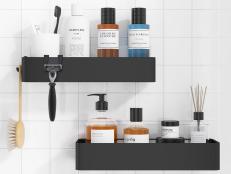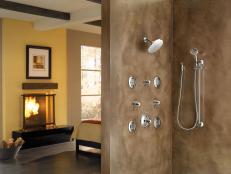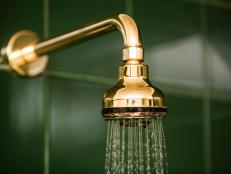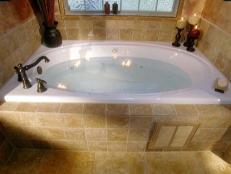Shower Makeovers
If the shower in your bathroom renders an anemic dribble while you stare at mildewing grout, it's high time for a shower makeover. Today's shower options replace the old drizzle with new sizzle and let you immerse yourself under a waterfall, melt away stress with multiple massaging sprays, or wrap up in a relaxing blanket of steam.
The options include both custom-made enclosures with your choice of materials and prefabricated units. High-quality custom showers can be framed with stud walls and finished with a variety of materials, such as tile, glass block, solid-surface material and marble. And it's become popular to enclose showers with walls and doors made of laminated safety glass.
Prefabricated shower kits come with a base, walls and a door and are available in a wide range of sizes, styles, colors and shapes, including rectangular, round and square. Generally fabricated of molded plastics such as acrylic or fiberglass, prefab units are also available in solid-surface material, which makes for a durable and nearly maintenance-free shower stall.
Creating Shower Stalls
Creating a shower in your new bathroom can be as simple as adding doors to the bathtub. The most common style is the bypass door, which consists of two doors that slide in a frame mounted to the tub's end walls. The other side, namely trackless doors, has no top or bottom tracks; the doors retract and pivot to allow full access to the tub area. With either type, you'll have a choice of glass styles and hardware finishes.
Shapes for stand-alone shower stalls include square, rectangular, corner and curved. In addition to the shape and size of the base, you'll need to decide on the threshold, which is the number of sides that will be enclosed by the glass sides and door. A single threshold is designed to fit in an alcove with walls on three sides; a double threshold tucks into a corner, with glass on the other two sides; and a triple-threshold base has a wall on one side only, with glass sides and a door on the other three sides.
A shower can be as small as 32 by 32 inches, but a 36-by-36-inch shower is considered the minimum for comfort and safety; anything smaller limits elbow room and the ability to step out of the stream if water temperature suddenly changes. To make shaving in the shower easier, include a fog-free mirror and a niche or a self-draining shelf for shaving accessories. And for safety, all shelves should be recessed into alcoves. Eliminate as many protrusions as possible in and around showers and tubs to avoid injuries.
Faucets should be accessible from outside and inside the shower enclosure so that the water flow and temperature can be adjusted from either place. Shower faucets should be offset toward the shower door rather than centered below the showerhead. This makes it easier to control the water flow without getting wet when turning the shower on.
Standard shower faucets are available with separate hot and cold controls or with a single-handle control. Spending more for high-quality shower controls will probably pay off in longer, more trouble-free service.
Reducing Water Use
A flow aerator is the most important water-conservation device your shower can have. It makes efficient use of the water that flows through it a faucet or showerhead, usually by mixing air into the water stream. It can cut back on water use and the amount of energy used to heat the water by as much as 50 percent.
If an aerator is already installed on the end of your faucet, you should be able to read its rated flow imprinted on the side. The rating should be no more than 2.5 gpm (gallons per minute). If your aerator is rated at more than 2.5 gpm, it should be replaced.
A showerhead's flow rate may also be stamped on its side, and it, too, should be rated at no more than 2.5 gpm. If you can't see a rating on your showerhead, you can test it. Hold a 2-quart saucepan under the showerhead, turn the shower on full and time how long it takes to fill the pan. If it takes 12 seconds or less, a low-flow showerhead is recommended.
Most low-flow showerheads are the aerating type. The air mixed into the water stream by an aerating head helps maintain steady pressure, so the flow from the shower is full and even. But mixed with air, the water can cool as it nears the shower floor. For a strong spray, there are also non-aerating showerheads, which don't mix air with water. This gives the flow a strong spray with even temperatures, but the shower water also tends to pulse as a massaging showerhead might.
Note: You'll need to have a plumber determine whether your home's water pressure is sufficient to accommodate the water features you desire.
Reprinted with permission from NKBA












































